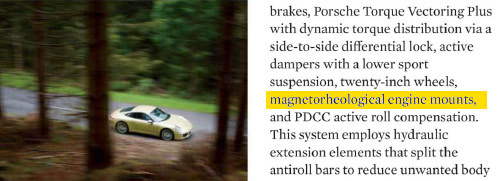First posted Oct. 22nd., 2011 in my motorsports blog, which is now closed.
Can there be a more boring topic for a blog post than engine mounts? I mean, they are just chunks of hard rubber, bonded to two metal plates, which are bolted to the engine and a cross member. What more is there to say?
Well, my lunchtime reading today was the November issue of Automobile magazine. It has a review of the new and highly-desirable Porsche 911 – to be released as the 991.
I suppose I’m not as fanatical about cars as some. I don’t memorize every last detail. I tend not to read whole articles, but rather the first few words of each paragraph in order to filter out the meaty bits. I believe that’s how most people read web pages. Maybe that’s how you’re reading this blog.
Well, there I was, scanning, scanning, “Porsche Torque Vectoring” blah blah blah “dynamic torque distribution” blah blah blah “magnetorheological engine mounts” blah…
And suddenly I’m thinking “engine mounts? This must be a misprint.” Like I said at the beginning, engine mounts are those boring solid rubber thingies.

But, when in doubt, Google.
The first thing I learned is that magnetorheological fluid is also known as MR fluid. That’s a little easier to say and write, but I was thinking it would be MH fluid, because I was reading it as magnetor-heological fluid. Mistake #1. It’s magneto-rheological fluid. Slap on wrist.
It’s known as a “smart fluid” because when subjected to a magnetic field, it greatly increases its viscosity, to the point of becoming almost solid. Hmm, that is smart. By using electromagnets the Porsche designers figured out how to make the engine mounts stiffer at high revs, in order to provide a more precise gearbox shifter feel.
I’m sure it also allows the Porsche service personnel to add a few thousand (insert your currency here) to the service bill. “Well, you see Sir/Madam, we had to change the magnetorheological fluid in your engine mounts.” [Sir/Madam stares blankly and pulls out Platinum AMEX card.]
But, let’s not dismiss this stuff, MR fluid that is, as a whim of Porsche. It seems that as the technology develops, it’s use will expand. When used in suspension, the damping factor can be adjusted once every millisecond in response to conditions. It has military applications and will eventually be used in bullet-proof vests, and it was even used as a fluid-based optical polishing method on Hubble Space Telescope’s corrective lens.
All of which answers my question “What’s wrong with rubber?”
